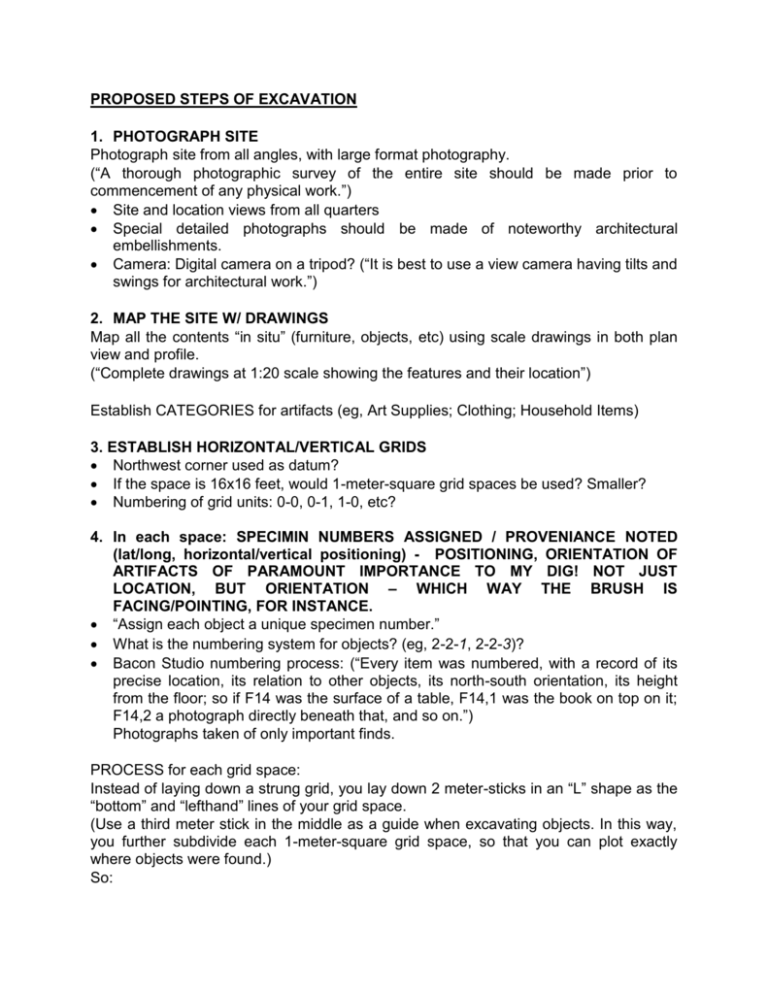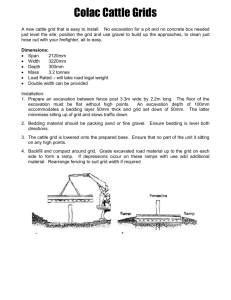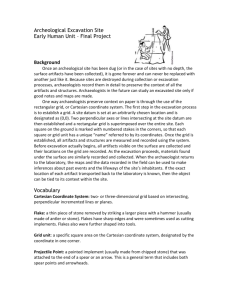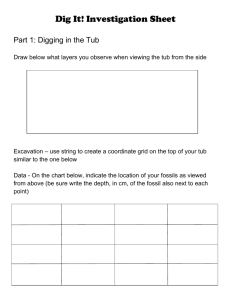Archaeology questions - chrisvanstrander`sworkPal
advertisement

PROPOSED STEPS OF EXCAVATION 1. PHOTOGRAPH SITE Photograph site from all angles, with large format photography. (“A thorough photographic survey of the entire site should be made prior to commencement of any physical work.”) Site and location views from all quarters Special detailed photographs should be made of noteworthy architectural embellishments. Camera: Digital camera on a tripod? (“It is best to use a view camera having tilts and swings for architectural work.”) 2. MAP THE SITE W/ DRAWINGS Map all the contents “in situ” (furniture, objects, etc) using scale drawings in both plan view and profile. (“Complete drawings at 1:20 scale showing the features and their location”) Establish CATEGORIES for artifacts (eg, Art Supplies; Clothing; Household Items) 3. ESTABLISH HORIZONTAL/VERTICAL GRIDS Northwest corner used as datum? If the space is 16x16 feet, would 1-meter-square grid spaces be used? Smaller? Numbering of grid units: 0-0, 0-1, 1-0, etc? 4. In each space: SPECIMIN NUMBERS ASSIGNED / PROVENIANCE NOTED (lat/long, horizontal/vertical positioning) - POSITIONING, ORIENTATION OF ARTIFACTS OF PARAMOUNT IMPORTANCE TO MY DIG! NOT JUST LOCATION, BUT ORIENTATION – WHICH WAY THE BRUSH IS FACING/POINTING, FOR INSTANCE. “Assign each object a unique specimen number.” What is the numbering system for objects? (eg, 2-2-1, 2-2-3)? Bacon Studio numbering process: (“Every item was numbered, with a record of its precise location, its relation to other objects, its north-south orientation, its height from the floor; so if F14 was the surface of a table, F14,1 was the book on top on it; F14,2 a photograph directly beneath that, and so on.”) Photographs taken of only important finds. PROCESS for each grid space: Instead of laying down a strung grid, you lay down 2 meter-sticks in an “L” shape as the “bottom” and “lefthand” lines of your grid space. (Use a third meter stick in the middle as a guide when excavating objects. In this way, you further subdivide each 1-meter-square grid space, so that you can plot exactly where objects were found.) So: You lay down your meter sticks. You ALWAYS place a NORTH ARROW in the photograph as well. AND you place a scale next to significant finds. (There are north arrows that ARE scales, have scales on them. Let’s use one of these, getting us a scale AND an arrow in one.) Take a planview photograph of each unexcavated grid space. Then, excavate it. 5. OBJECTS REMOVED Remove and bag each object. Excavation proceeds up 0-0, 0-1, 0-2, 0-3, Which direction across grid does the excavation proceed? Starting NW corner, proceeding South? East? LOGGING/WRAPPING ARTIFACTS Duties are switched/rotated. Archaeology = LEARNING. Teaching young archaeologists. It’s important for EVERYONE TO LEARN EVERYTHING. That’s what fieldwork is for. So that you develop ALL skills. (Like the carpenters’ apprentice on This Old House – he goes, helps w/ anywhere that’s needed. Windows, plumbing, etc.) One person does the excavation/removal and another team member is in charge of tagging/wrapping/packing the objects for transport. Then they switch jobs. Staging area for the excavated objects is directly outside cabin. Big bins, by grid space (and, I guess, bagged by category?) It’s ok that the objects hang out right outside in bins, there’s no real danger of, say, dust storms or contamination. It’s a small, controlled site. 6. DISSASSEMBLE BUILDING ITSELF “Since the building is being disassembled for transport, number each component and document its relationship to the surrounding components.” 7. BACK IN LAB: ARTIFACTS CLEANED/DESCRIBED/ANALYZED. “Back in the museum lab: each artifact is individually cleaned/dusted, described, and analyzed.” Basically, an Excel database is created mimicking the info on the bagged objects’ bags. (where they were found, orientation, category, etc) This is where object-conservation decisions are made. NOTES/PHOTOS/SITE LOG “All of this activity would be accompanied by exhaustive note taking and photography that documented every aspect of the project.” [MATT RIZZO: “This was obviously written by an archaeologist.” ] Put the objects into the bags; label the bags meticulously-detailedly, and that’s enough of a site log for us. The site log, for this play, can be the bagged objects. On a dig, you’re working against TIME. You have to go fast, fast, fast. Get it done. So, no time to really sit there and muse. On a dig in the field, your goal is to just get the objects in the bags. So, just get us through the bagging process. That’s far enough. “A log/site diary would be kept that gave the date, time, and description of any event of sufficient importance.” On site: no computers, you just write on the bags, and on Grid Square sheets – which have a plan view drawing of the grid and objects in situ on the top, and written info on each grid on the bottom. No laptops or anything in the field. ADHERENCE TO REGULATIONS “If the project was purely a privately funded concern, the only restrictions would be those set by the property owner (and possibly some state or local restrictions).” So is there leeway on the excavation techniques used? CABIN AS FROZEN-IN-TIME CAPSULE Documenting the exact location of a historic building’s interior contents rarely comes up due to the constant reuse of buildings over time. Historic structures are rarely “time capsules” such as your cabin. BACON STUDIO: “I was struck by the ease with which archaeological processes could be so readily applied in the unusual context of the Bacon Studio.” Notion of REUSE! (eg, the a) stone that’s then [re-]used as a b) tool. This is a concept we can use. Reuse = the bill of sale used as an inventory, or whatever it is, in Act 3. VAN EXCAVATION PROJECT – yup, all that’s fine. “Fieldwork followed convention, with survey, surface collection and excavation in the usual order. The body of the vehicle was recorded in much the same way as a standing building. Scale photographs were taken and drawings made of all internal and external elevations, floors and ceilings. Internally, there were three main stratigraphic layers: a carpet, a plywood lining and the metal body. Each layer revealed its own distinctive collection of artefacts and palaeoenvironmental material. All finds were photographed, planned at 1:10, recorded and then collected on a 20cm grid. As parts were removed they were inspected, measured, photographed and recorded. Their age, condition and any other information was noted on specially designed context sheets.” SCHOOLS OF OBJECT ANALYSIS – yup, he recognized them all. “The student of material culture can approach an object from a variety of vantage points: Finley Flemming Prown McCracken Forty” “The second you’ve dug, that’s it. You do/dig/extract something once, it’s destroyed. So if you fuck it up, it’s OVER.” “Armchair archaeologists” = pick up on field workers’ mistakes. (Fieldworker: Look, I found a stone tool that we didn’t think should be here, and changes our ideas of this tribe! Armchair: “Oh yeah? Precisely how far down did you dig?” Fieldworker: Uh… I don’t know, I didn’t record that. Armchair: “Well, forget your tool then, and your discovery. It’s meaningless – since you can’t verify it.”) You MUST mark down EVERYTHING you do, to cover your ass EXHAUSTIVELY against armchair archaeologists. Archaeologists are insanely meticulous and redundant about their work, taking insane amounts of anally-precise notes. *In this scenario, J is the armchair archaeologist. Cassie has worked/lived in the field, so to speak. But J comes along, C has had some sloppy methods or is going on mere hunches, and J gets her, traps her w/ that. SPECIMEN NUMBERING SYSTEM: BS01 (Site name: Bacon Studio 01) Square 1,3 x,y (coordinates w/in Square 1,3) = 5,6 (5 cm/6 cm)





